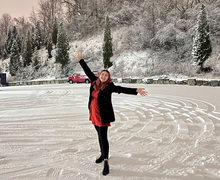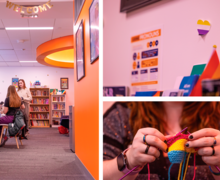University monitors energy use during frigid winter stretch
With temperatures dropping below zero this season, Syracuse University buildings are working overtime to keep students comfortable and facilities functioning.
Throughout campus, an energy management system acted as a watchdog over many of the university’s buildings, monitoring the temperatures and controlling when the heat came on, said Emily Greeno, energy conservation manager for SU’s Climate Operation Center. The center operates within the university’s Energy Systems & Sustainability Management Department.
Campus buildings’ temperatures usually vary each day, with heat kicking in to maintain an average temperature of 68 degrees during classes and 55 degrees at night when no one is in the building.
However, last week, before the 40 degrees thaw on Saturday, the heat stayed on at full blast, which increased the university’s energy consumption, said Nathan Priors, associate director of energy consumption.
“We were running the buildings 24/7 to avoid freeze-ups and people being uncomfortable in the facilities,” Priors said. “As much as we want to have energy conservation, at the same point in time we want people to be productive. So we need to find an appropriate balance between occupant comfort and energy conservation.”
SU is primarily powered by steam heat, and the colder weather demands significantly higher loads of steam to keep everything functioning, Priors said. He added that this could notably affect SU’s energy bill for the fiscal year.
“Obviously the month of January we used more steam than last January, but the total dollars we are going to spend for the year is to be seen,” said Priors. “If the rest of the winter proves mild it could average itself out.”
The extreme temperatures stress the equipment to their maximum capacity, so the university has created a preventative maintenance program that gives the equipment very little opportunity to break down, said Ray Kowalski, facilities maintenance manager.
Kowalski is the manager for the west zone of campus, which includes buildings such as Maxwell, Eggers Hall, Hall of Languages, Hendricks Chapel and several others. If students and faculty leave windows open, it can become difficult to regulate heat in each building, Kowalski said. The drastic difference between the temperatures inside and those outside can cause radiators to freeze up and break.
Just before the holiday vacation, Kowalski said one of the radiators in Maxwell cracked causing steam and condensation to run over everything.
To avoid problems with the freezing temperatures, Kowalski said the night maintenance crew walked through the buildings several times when temperatures only reached single digits to ensure that there were no windows left open.
Students across campus may feel that certain buildings are cooler or warmer than others, Greeno said.
“You can definitely see older systems in the older buildings so they either have to run more or they don’t have as good temperature control on them,” Greeno said. “But then when we install newer buildings, you will see they have a lot more space temperatures and ability to control temperatures.”
Many of the calls Energy Systems and Sustainability Management receives during the winter are about occupants just feeling chilly. There can be equipment problems, but sometimes people feel that 68 degrees is too cold. Other cases include someone using a space heater near a temperature sensor, which freezes out their neighbor in the other room whose heat is determined based on that sensor, Priors said.
Although it can be difficult, Priors said they are constantly looking at ways to reduce the energy consumption at SU. Certain projects underway are associated with SU’s Climate Action Plan, for which construction will begin post commencement this year, Priors said.
According to the plan published in 2009, the goal is to get the university’s greenhouse gas emissions down to net zero by 2040.
Priors said the department has done studies on solar power and wind generation on South Campus to see if they’re feasible solutions for the university’s greenhouse emissions.
“If everyone took little steps to reduce their energy consumption it could be very significant,” Priors said. “It is a very interesting challenge.”
Published on February 6, 2014 at 12:24 am
Contact Kate: kacapoda@syr.edu





